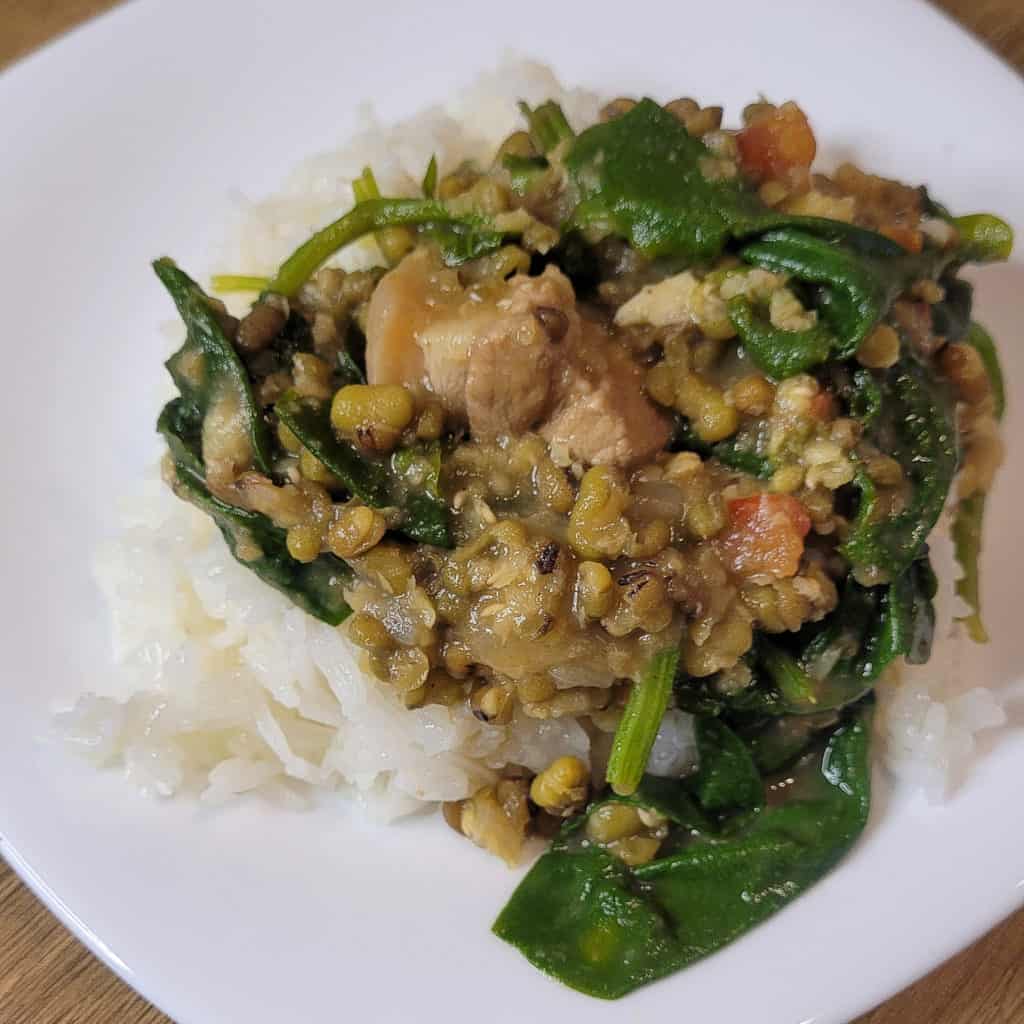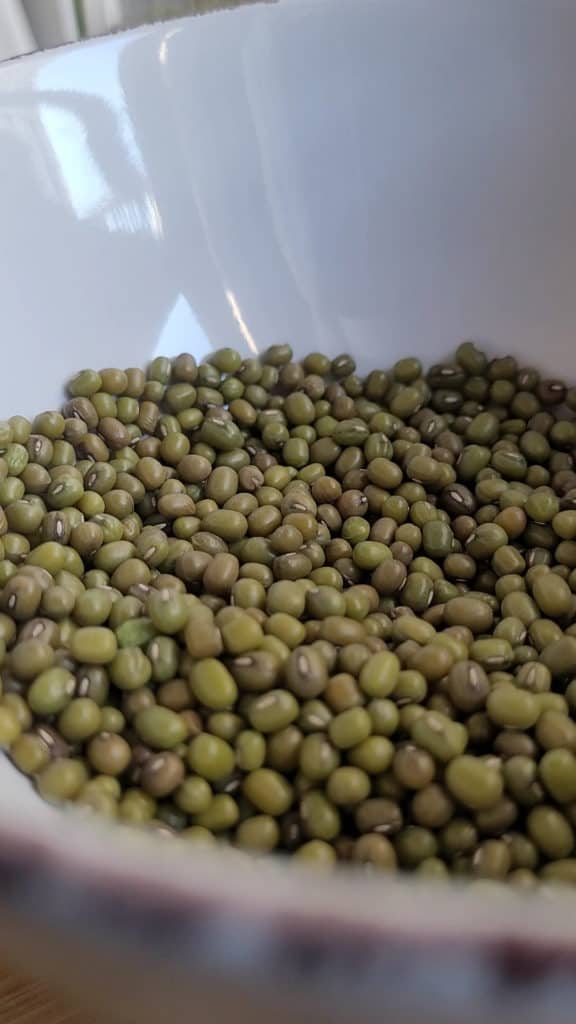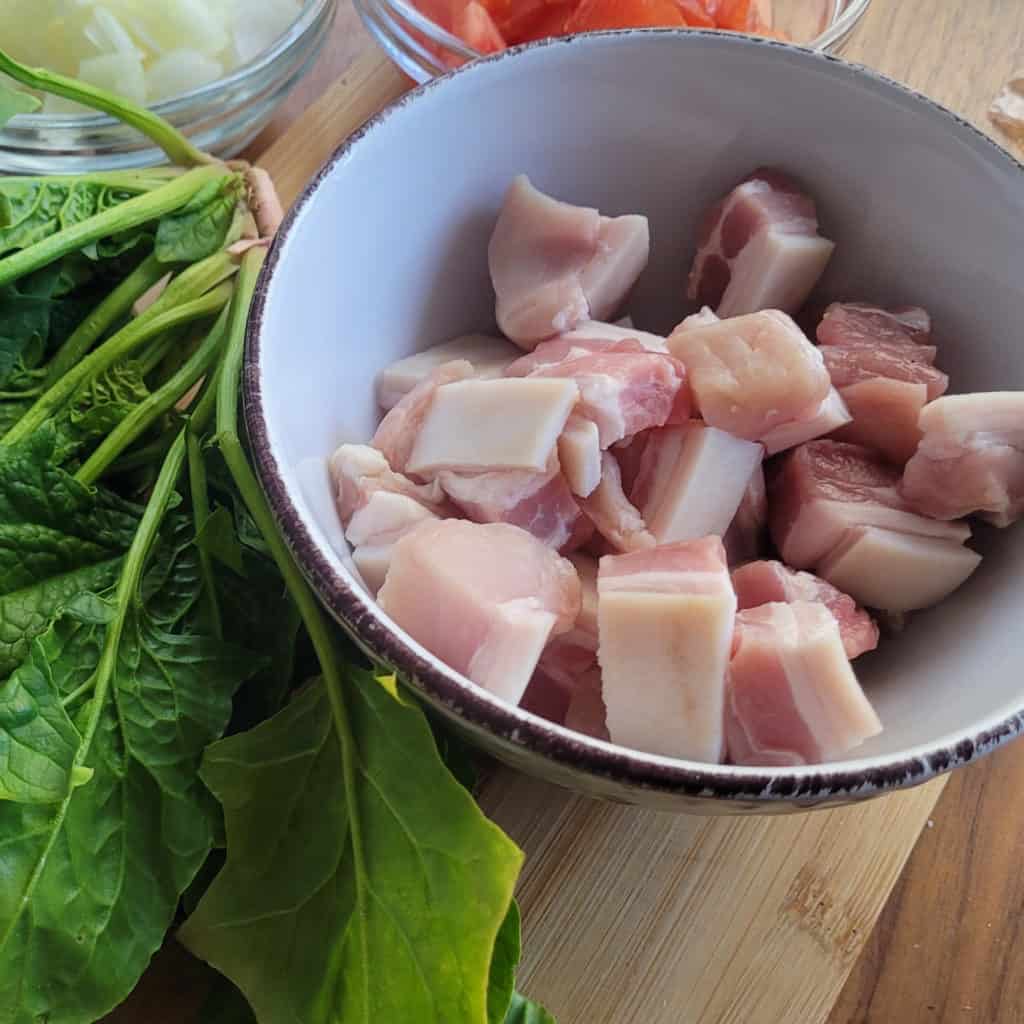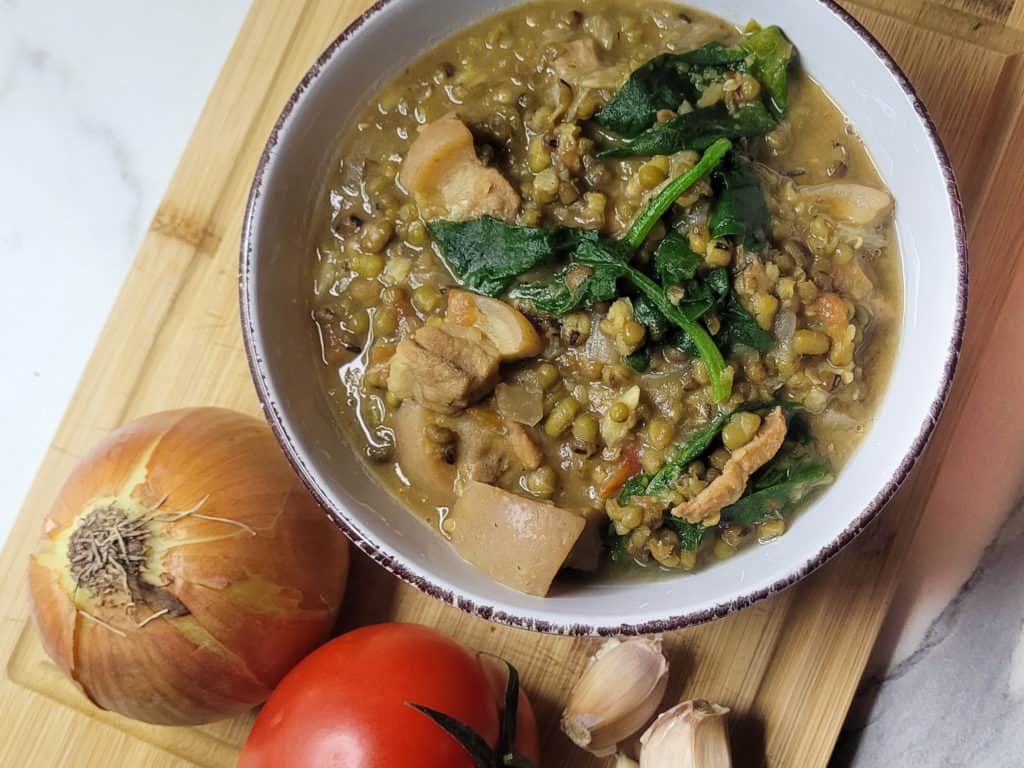Disclosure: Some of the links in this post are affiliate links. This means if you click on the link and purchase an item, Sees Food, Will Travel will earn a commission at no extra cost to you. See terms and conditions for details.
Monggo (stewed mung beans) is famous for being a Filipino comfort food recipe. It's a simple and hearty dish that I grew up with. As a child who didn't like vegetables, this was the only one I tolerated. This monggo recipe is a variation of the authentic Filipino version by replacing malunggay (moringa leaves) with spinach.

Update Disclosure: This post has been updated for one or more of the following reasons: easier reading, updated photos, clearer instructions, and just plain ol' improvements to the recipe (as noted).
Jump to:
I feel that monggo deserves a place in the more popular section of Filipino food alongside adobo and lumpia. Every Filipino family makes it often and has their own version.
In the Philippines, monggo is considered ulam, a dish consisting of protein partnered with rice.
What is in Monggo?

It's a good thing monggo is a flexible dish! Since I live abroad, my resources are limited, and I work around what is available. My Filipino version of monggo recipe consists of a few ingredients, including mung beans, pork, tomatoes, onions, garlic, spinach, and bouillon.
If you want to take the more traditional route, look for a leafy vegetable called malunggay and replace the spinach with it. Malunggay is considered a "superfood" packed with even more vitamins and minerals.

Overall, I consider monggo a relatively healthy dish that provides you with a solid amount of fiber, vitamins, and minerals.
Adapt This Dish to Your Desire
You can choose to substitute the leafy vegetable in this Filipino monggo recipe with whatever is available to you. Besides malunggay or spinach, you can also use watercress, kale, or swiss chard. If you want a stronger vegetal taste, try adding bitter melon.
You could also replace pork belly with chicken or beef. My family makes monggo with shrimp and pork, which is typical in other Filipino households. So feel free to mix and match proteins as long as you don't add too much of it.
Take some deep-fried pork rinds or chicharron and put it on top of cooked monggo to make it more traditional. It adds a crunchy and indulging element to the bowl!
I've even seen someone use hard tofu instead of meat for a vegetarian version. That person also switched the meat-based bouillon with vegetable bouillon.
Follow These Recipe Steps and Tips to Make Perfect Filipino Monggo
Cooking mung bean for this Filipino monggo recipe is easily done by boiling it for a while. Before starting, all you need to do is set your mung beans aside in a bowl of water while you chop your vegetables.
Throw in your chopped garlic and onions to let those aromatics cook together. Add the tomatoes and cook with the onions and garlic for two minutes. Then add your pork slices to the pot to let it brown. You don't need to see grill marks on your pork since you will be boiling them anyway, so make sure you have thoroughly cooked your pork.
The next step is to add the chicken bouillon. I think it gives monggo that chicken soup essence that I find very comforting! Finally, add in the mung beans (without their water) and fill the pot with six cups of water. Then cover it to let it continue simmering.
How to Check if Your Mung Beans are Cooked
Check every ten minutes to make sure the beans haven't soaked up all your water. I have had to re-add water once or twice to keep the ingredients from burning. After about thirty to forty minutes, your mung beans should have split. If you bite into one, the texture should be soft and just barely have a bite to it. You can consider your mung beans cooked at this point!
Before you turn off the heat, add in your fresh spinach and stir a couple of times to mix the spinach leaves into the pot. This part is optional, but you can choose to put fish sauce into your monggo dish. Two tablespoons of fish sauce will add more umami flavor to monggo.

And there you have it! Monggo is an easy Filipino recipe that you can make with a few very simple ingredients. Because of the amount of mung beans used, this ulam may not look appetizing to some people. But once you taste this, I can assure you that you will feel like it's a hug in a bowl.

Filipino Monggo (Mung Bean Stew) Recipe
Disclosure
The equipment and ingredients sections contain affiliate links to products I love to use as well as items that I personally believe make this recipe the best version of itself.
Ingredients
- 1 onion, diced
- 1 large tomato, diced
- 4-5 cloves garlic, crushed
- 1 tablespoon vegetable oil
- 175 grams meat of your choice, cubed pieces pork belly, beef, chicken, shrimp
- 200 grams dried mung beans
- 1 cube chicken bouillon (10-12 gram pieces)
- 1420 ml water
- 1 bunch spinach leaves
- 1 - 2 tablespoon fish sauce optional
Instructions
- Add oil to pot and set to medium heat. Add garlic and onions, then saute until onions are clear.
- Add tomatoes and saute for two minutes.
- Add your meat (except shrimp) and cook until brown.
- Add water, mung beans, and chicken bouillon then bring to a boil.
- Keep boiling until beans are soft yet still have a bite to them (about 45 minutes). Add more water to the pot to keep the liquid from disappearing. Otherwise you will burn the monggo.
- When beans are cooked, add shrimp at this stage if you are using shrimp as your meat. Stir in the spinach and continue boiling for three minutes or until shrimp is slightly firm then turn off the heat
- Optional: Stir in fish sauce before turning off the heat
- Serve over white sticky rice and enjoy!

Nutrition
Have You Tried This Recipe?
Simply rate the recipe by clicking on the ⭐️s on the recipe card. Have something to say? Please leave me a comment down below telling me what you think of this recipe.
Bonus: Let me and other readers know what you did to make this recipe your own - 💫 let's inspire each other!
Also, follow me on Instagram [@seesfoodwilltravel] and send me a DM with a picture of what you made. I would love to share and celebrate YOUR creation with our budding community 💞
Check out Sees Food, Will Travel on Pinterest and Facebook for more delicious updates.







Lea says
This dish came out great! I left out the pork and used vegetable bouillon instead. I also added a serrano for a nice spice. It took 45 minutes of covered boiling. Will make again, thanks for sharing!
Joanne says
Thank you so much! I'm glad the recipe turned out well for you. Thanks for note on covered boiling, I'll update the post regards this!
Lisa says
I used shrimp instead of pork and it was delicious! Next time I think I’ll put in my shrimp a little later so it doesn’t overcook. Thank you for sharing this recipe! Reminds me of home.
Joanne says
I'm so happy to hear it! I consider this one of my top Filipino comfort foods too. Good note on the shrimp, it doesn't take much to overcook. I'll add it as an option to the recipe as well!
Rosann says
I like your blog
Joanne says
Thank you, Rosann! Hope you found something informative and helpful!